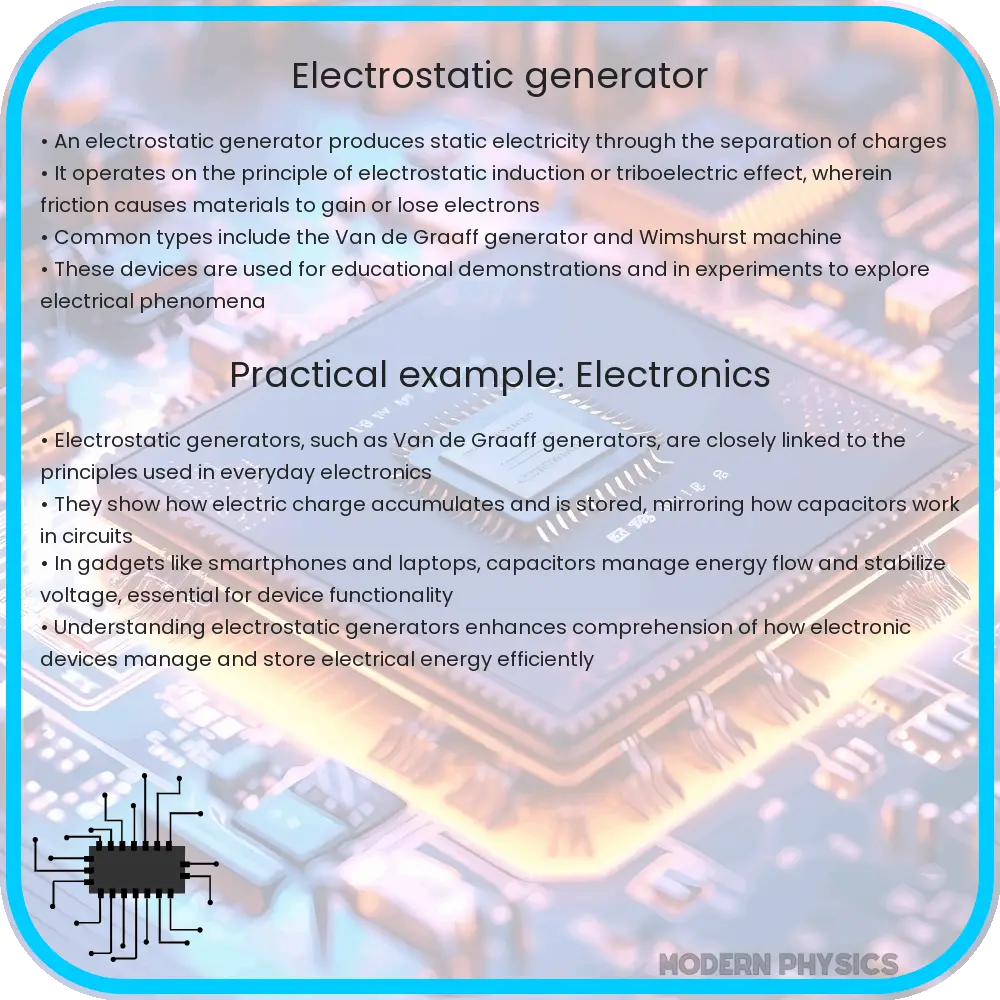Explore the world of Electrostatic Generators: safe, efficient, portable solutions for energy needs, with a focus on their science, advantages, and applications.

Understanding Electrostatic Generators: A Leap in Portable Energy Solutions
Electrostatic generators, also known as electrostatic machines, are devices that produce static electricity or electricity at high voltage and low continuous current. The principle behind these generators is based on electrostatic induction or triboelectric effect, making them an innovative solution for various applications where efficient and portable energy is crucial.
The Science Behind Electrostatic Generators
At the heart of an electrostatic generator lies the basic principle of electrostatics, where charge is generated through frictional contact between materials. When two different materials come into contact and are then separated, one material becomes positively charged, while the other gains a negative charge. This phenomenon is known as the triboelectric effect. The accumulated charges can be harnessed and transferred to conductive electrodes, creating an electrical potential that can be used as a power source.
One common example of an electrostatic generator is the Van de Graaff generator. This device uses a moving belt to accumulate electric charge on a hollow metal globe on the top of the stand, creating high voltage.
Advantages of Electrostatic Generators
- Safety: Electrostatic generators operate at high voltage but low current, which significantly reduces the risk of electric shocks, making them safer for use in various environments.
- Efficiency: These generators have minimal moving parts, leading to reduced wear and tear and thus enhancing their efficiency and longevity.
- Portability: Due to their simple design and lack of heavy components, electrostatic generators are inherently lightweight and portable, ideal for applications where mobility is key.
Applications of Electrostatic Generators
Electrostatic generators find applications in numerous fields:
- Education and Research: They are commonly used in educational settings to demonstrate the principles of electrostatics and electricity. In research, they aid in experiments requiring high voltage at low current.
- Industrial Applications: In industries, they are used for static charge neutralization, material separation, and in some types of particle accelerators.
- Consumer Products: Some consumer products, like air purifiers, utilize electrostatic generators for trapping pollutants.
The versatility and safety profile of electrostatic generators make them an invaluable tool in modern technology, opening new frontiers in efficient and portable energy solutions.
Challenges and Future Prospects
Despite their advantages, electrostatic generators face certain challenges. The most notable is their limitation in providing continuous, high-power output, making them unsuitable for applications requiring sustained energy supply. Furthermore, environmental factors like humidity can affect their efficiency, as moisture in the air can dissipate the accumulated charges.
However, ongoing research and technological advancements are addressing these challenges. Innovations in materials science, such as the development of more efficient and humidity-resistant materials, are enhancing the performance of electrostatic generators. Additionally, integrating these generators with other energy systems could lead to more versatile and powerful energy solutions.
Environmental Impact and Sustainability
Electrostatic generators have a minimal environmental footprint. They don’t rely on chemical reactions, as in conventional batteries, or burn fossil fuels, making them an eco-friendly option. Their ability to generate electricity through mechanical means makes them a promising technology in the quest for sustainable and clean energy sources.
Conclusion
In summary, electrostatic generators represent a significant step forward in the quest for safe, efficient, and portable energy sources. Their unique working principle, based on the triboelectric effect and electrostatic induction, offers numerous advantages, including safety, efficiency, and portability. While they face challenges in terms of continuous power output and environmental sensitivity, ongoing research and innovations are continually expanding their potential applications.
Their minimal environmental impact further underscores their role in sustainable energy solutions. As we move towards a future where the demand for versatile and eco-friendly energy sources is ever-increasing, electrostatic generators stand out as a promising technology, paving the way for innovative applications in various fields ranging from education and research to industrial and consumer products.
Electrostatic generators, with their unique blend of simplicity, efficiency, and environmental friendliness, are more than just an educational tool; they are a testament to human ingenuity in harnessing the fundamental forces of nature for practical and sustainable applications.
